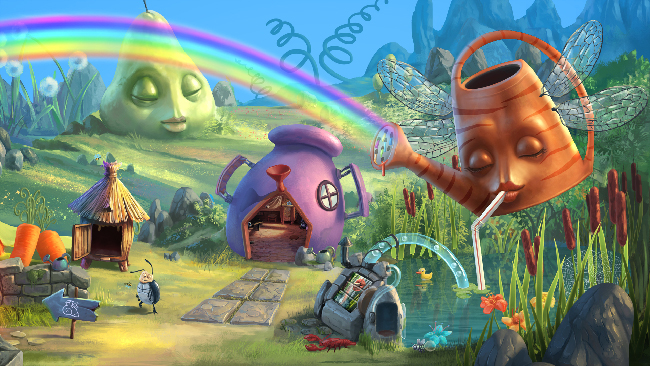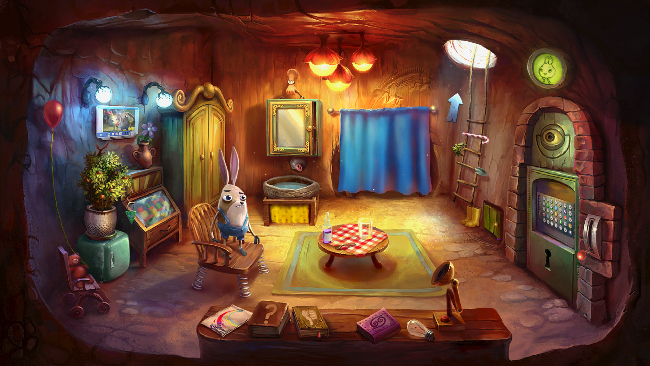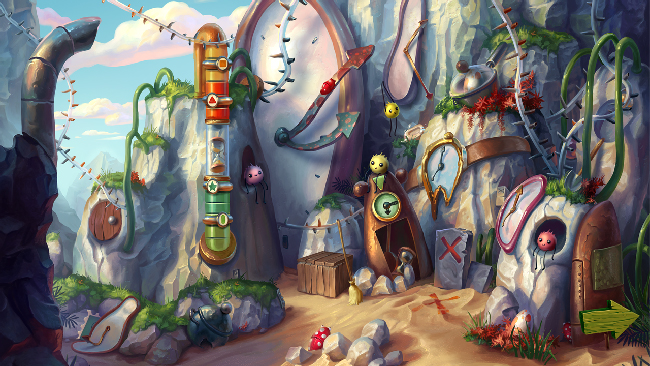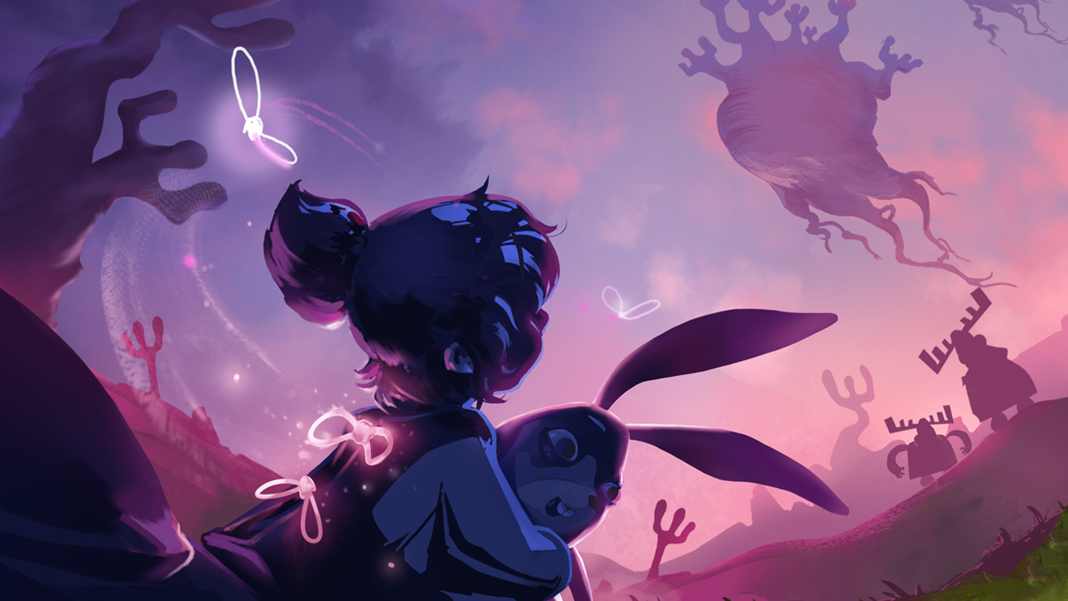Looking at the art, lush and beautiful and like an intricate children’s book, I sat down with My Brother Rabbit for what I thought would be a relaxing but contemplative, even somber game based on little bits of a tragic story in the opening.
It soon became wholly frustrating as I realized the puzzles were a lot of tedious fetch quests often making me go back and forth, drastically slowing things down with not much to show for it. It got to the point where I just felt like getting through the game rather than enjoying it.

Not Much Actual Substance
Developer Artifex Mundi’s My Brother Rabbit is a puzzle adventure game about a boy using his imagination to cope with his sister’s sudden illness and hospitalization. The player takes control of the boy’s avatar in his fantasy, a rabbit who goes on a quest to help his sick friend, a sentient plant who clearly symbolizes his sister’s crisis.
There seems to be a whimsical, surreal, emotional story about a family’s love and distress, but it becomes very easy to lose sight of that when you find the game itself isn’t something you want to play.

There wasn’t much to motivate me to press forward in My Brother Rabbit beyond the idea of just getting it over with. There isn’t actually much story or character development to entice; what exists is barely explored, and largely confined to picture book-styled cinematic scenes that continue to provide visual interest, but aren’t that engaging as a whole.
The game seems to want to subtly tell a story that’s like something on the edges of a child’s awareness. But it ends up feeling too sparsely detailed, to the point that it feels overly vague, like there’s barely anything there.
Tedium Overrides a Vibrant Setting
There’s asking for patience—but the game’s puzzles cross over into slowing things down considerably with a lot of backtracking right off the bat. Frustration mounted to the point that I overlooked the little touches of visual whimsy the game tried to inject into the experience.
The illustration for the game world is beautiful, colorful and intricate, filled with the fantastical and surreal. But that ended up mattering little to me when I went back to a previous stage for the umpteenth time to check if maybe there was an item I missed and needed to add to my collection to complete a required mission objective.

The world is visually gorgeous, but it ended up being a world I didn’t enjoy, a world I didn’t want to play in—or spend so much time wandering around back and forth in while I searched for one more inane object, like a clam.
A Frustrating Pattern
Gameplay often got to the point of doing a lot of random aimless clicking while trying to figure out the next move, or trying to find the right item that could trigger the next clue that would let me advance only marginally. The game was rarely consistently clear about what could be interacted with, and what was static and a waste of time to click.
So much of My Brother Rabbit was just one find-and-collect quest after another. Like finding a set of butterflies would only lead to me searching for something else, such as a set of stamps, and so on and so on, over and over again. The objects may have superficially differed, but the find-and-collect action remained the same, feeling too numbingly repetitive, and comprising the bulk of gameplay.

Other puzzles that tried to break this monotonous pattern by offering something different frequently had confusing hints that just furthered my frustration, and only served as more obstacles to get over with, providing little playful pleasure.
Some Bright Spots and Stumbling at the Finish Line
There was one puzzle type that felt interesting: it was another fetch quest, but I felt more motivated to do it because with every piece I found, the music changed, gaining a new beat or instrumental sound; and all the pieces I had to find were in one room, there was no back and forth between different areas. I felt like I was making real and steady progress with this puzzle, it didn’t feel like gameplay had slowed to a crawl.

Thankfully more puzzles like this one crop up, and are genuinely a welcome change of pace. The last puzzle of the entire game is actually like this—and at that last puzzle, I finally felt more of a sense of melancholy about the story the game has been trying to tell.
At that point, there are no more glimpses of hope; the player character’s sister is clearly in a dire situation. The music becomes more focused on emphasizing that despair. With each puzzle piece found, the music changes and gradually builds up into a new mournful reprise and remix of what admittedly had become a rather grating melody before then due to how often I’d get stuck listening to it. Any change with that piece of music was welcome. (But the soundtrack as a whole was forgettable to me, the largely tedious gameplay overwhelmed it and the dazzling visuals.)
And with this final puzzle moving better, leaving me with the sense that I was progressing at a steady pace, I was better able to take in the visual details, actually interpret what I was seeing, and feel some sadness over it.
Essentially the final puzzle is littered with broken toys and items standing in for the emotional trauma of the brother and sister that the game has been trying to follow. Of course the goal is to find and collect, but the act of using what’s found to repair what’s been broken while the music developed made things feel less frustrating, and more poignant and engaging instead.

But then that momentary show of emotion is abruptly cut off by another picture book-styled cinematic scene that feels more rushed than the other ones, and the game just ends. Any emotional weight feels lost due to that sudden conclusion.
The last cinematic scene seems to want to push that a happy ending ultimately happened, but it’s rather disconnected from what came before. And again, it’s rushed; I was confused and mentally scrambling to understand what just happened while the credits had already started rolling (though admittedly the sight of the credits made me feel relieved).
I wondered if I was supposed to question that last scene. Like was it the truth, or only the character’s fantasy about a happy ending? And in the end I lost interest, because the game hadn’t actually made me care that much about what happened in it.

Pros
- Beautiful art style.
- One puzzle type set is more engaging due to the music changing and developing as the puzzle progresses forward.
- Ultimately short with five lands to play through, each land dividing into multiple stage areas.
Cons
- A constant stream of frustrating find-and-collect quests and other tedious puzzles.
- Unclear in terms of what could be clicked and what couldn’t.
- Lacking in story and character.
- An ultimately rushed ending.
Conclusion
Though frustrating and with a tendency to drag on, the game is ultimately and fortunately a short affair. The visuals are lovely; the developer even released a digital art book for My Brother Rabbit on Steam. But the gameplay itself isn’t engaging, and story, character, and music are similarly lacking. If you like a lot of puzzles in any form, this may be for you. If you’re casual with puzzles, this may be just excessive.
(Note: Nintendo Switch review copy provided by developer Artifex Mundi.)



